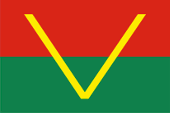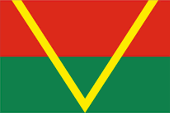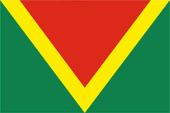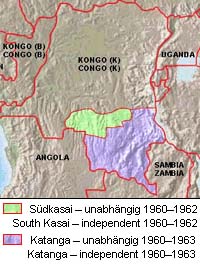mobile View, to the German Version tap the flag


- sezessionistische Region in Kongo-Kinshasa
- 1960–1962 unabhängig
• Flag
• Meaning/Origin of the Flag
• Coat of Arms
• Meaning/Origin of the Coat of Arms
• Map
• Numbers and Facts
• History
• Origin of the Country's Name

National flag,
ratio = 2:3,
Source, by: Wikipedia (EN)




National flag,
Variant,
ratio = 2:3,
Source, by: Flags of the World




defective and frequently used variant of the national flag,
Source, by: Flags of the World




The flag of South Kasai showed two horizontal stripes in red and green and in the middle of the flag an yellow "V". Some sources show the V reaching to the edge of the flag, other (even fotos) show it not reaching to the edge. Green, yellow and red are even known as the "Panafrican colors": Perhaps in 1900 was the beginning of the Panafrica-Movement, wich wants to emphasize the commons of all people with black skin. The colour-triad green-yellow-red, wich used many african and even american countries in their flags after the independence, stands for the political unity of Africa, of all black People. The first country was Ghana in 1957. As the origin apply the colours of Ethiopia (Abessinia), the oldest independent state in Africa. From the flag of South Kasai exists a defective variant which red and green shows above respectively below the "V". It has ist roots possibly in a wrong oral interpretation. Nevertheless it is frequently to see.
Source: Flags of the World, Volker Preuß


1960–1962,
Coat of arms of South Kasai,
Source, by: www.congoposte.be,
Dank an: antemister

The coat of arms of South Kasai showed a head of a leopard. The above depiction was derived by a stamp, which showed the same coat of arms like the constitution of the state.
Source: www.congoposte.be, Dank an: antemister

Location:

Source: Freeware, University of Texas Libraries,
modyfied by: Volker Preuß

Area: ca. 11.500 square miles
Inhabitants: ca. 1.000.000 (1960)
Capital: Bakwanga (name from 1966: Mbuji-Mayi), ca. 136.000 inh. (1960)
official Language: French
other Languages: Bantu Languages (Luba, Kuba ...)
Currency: 1 Congolese Franc (CDF, F, FC) = 100 Centimes
Time Zone: GMT + 2 h
Source: Wikipedia (D), www.congoposte.be

Before the conquest of Kongo by the Belgians existed in Kasai between the 15th and 19th century the Empire of the Kuba and the southern parts of the country belonged to the Luba-Empire of Katanga. Kasai became then a province of Belgian-Congo (today Congo-Kinshasa [Zaire]). During the confusions of the civil war before and after the declaration of independence of Congo-Kinshasa (30th of June 1960) declared the in mineral resources rich south of the province of Kasai its independence on the 14th of June in 1960 as "Autonomous State of South Kasai" under the Luba-Leader Albert Kalonji. On 8th of August in 1960 was proclaimed the "Autonomous Mining State of South Kasai". Capital became Bakwanga (the today’s Mbuji-Mayi). On 12th of April in 1961 the father of Albert Kalonji was proclaimed by the Luba as king, which his title immediately handed over to his son. President Kalonji named itself now Mulopwe (King) Albert I. Kalonji. Because of attacks of the troops of the premier of Congo-Kinshasa Lumumba resp. its successor Gizenga the cities of Bakwanga and Loulabourg were lost and Albert I. was captured. In the meantime the troops of Gizengas lose against the troops of Joseph Mobuto and Moise Chombe. On 7th of September in 1962 Albert I. succeeded in escaping from the imprisonment and he returned to the top of his for surviving fighting state, but South Kasai has to surrender only one month later. The Mobuto-Government partitioned the province of Kasai in a eastern province (capital Mbuji-Mayi) and a western province (capital Luluabourg/Kananga).
Source: Wikipedia (D), Volker Preuß

The country's name "Kasai" resp. "South Kasai" has its roots in the name of the Kasai River, which has its spring in the Lunda Country in Angola. It streams initially northwards and then in northwestern direction and unites as "Kwa" near the place Kwamouth with the Kongo River.
Source: Volker Preuß


![]()












